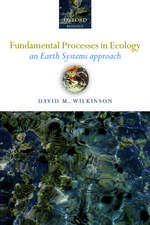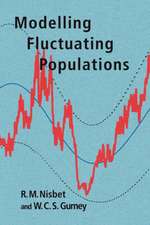Microbial Models: From Environmental to Industrial Sustainability: Microorganisms for Sustainability, cartea 1
Editat de Susana Castro-Sowinskien Limba Engleză Hardback – 30 noi 2016
| Toate formatele și edițiile | Preț | Express |
|---|---|---|
| Paperback (1) | 789.13 lei 38-44 zile | |
| Springer Nature Singapore – 8 iun 2018 | 789.13 lei 38-44 zile | |
| Hardback (1) | 808.32 lei 38-44 zile | |
| Springer Nature Singapore – 30 noi 2016 | 808.32 lei 38-44 zile |
Din seria Microorganisms for Sustainability
- 24%
 Preț: 794.72 lei
Preț: 794.72 lei - 18%
 Preț: 952.57 lei
Preț: 952.57 lei - 24%
 Preț: 1033.06 lei
Preț: 1033.06 lei - 24%
 Preț: 967.12 lei
Preț: 967.12 lei - 18%
 Preț: 1219.63 lei
Preț: 1219.63 lei - 24%
 Preț: 1196.29 lei
Preț: 1196.29 lei - 24%
 Preț: 1193.04 lei
Preț: 1193.04 lei - 18%
 Preț: 1229.10 lei
Preț: 1229.10 lei - 18%
 Preț: 1118.62 lei
Preț: 1118.62 lei - 18%
 Preț: 949.73 lei
Preț: 949.73 lei - 18%
 Preț: 1229.10 lei
Preț: 1229.10 lei - 24%
 Preț: 834.63 lei
Preț: 834.63 lei - 18%
 Preț: 1392.95 lei
Preț: 1392.95 lei - 18%
 Preț: 1117.82 lei
Preț: 1117.82 lei - 18%
 Preț: 1004.99 lei
Preț: 1004.99 lei - 15%
 Preț: 650.37 lei
Preț: 650.37 lei - 18%
 Preț: 948.61 lei
Preț: 948.61 lei - 18%
 Preț: 951.14 lei
Preț: 951.14 lei - 15%
 Preț: 643.48 lei
Preț: 643.48 lei - 18%
 Preț: 947.67 lei
Preț: 947.67 lei - 24%
 Preț: 793.30 lei
Preț: 793.30 lei - 18%
 Preț: 947.35 lei
Preț: 947.35 lei - 18%
 Preț: 1383.81 lei
Preț: 1383.81 lei - 24%
 Preț: 783.41 lei
Preț: 783.41 lei - 18%
 Preț: 948.79 lei
Preț: 948.79 lei - 24%
 Preț: 1052.02 lei
Preț: 1052.02 lei - 18%
 Preț: 1227.67 lei
Preț: 1227.67 lei
Preț: 808.32 lei
Preț vechi: 1063.59 lei
-24% Nou
Puncte Express: 1212
Preț estimativ în valută:
154.75€ • 161.46$ • 129.72£
154.75€ • 161.46$ • 129.72£
Carte tipărită la comandă
Livrare economică 08-14 martie
Preluare comenzi: 021 569.72.76
Specificații
ISBN-13: 9789811025549
ISBN-10: 9811025541
Pagini: 475
Ilustrații: IX, 349 p. 64 illus., 28 illus. in color.
Dimensiuni: 155 x 235 x 24 mm
Greutate: 0.82 kg
Ediția:1st ed. 2016
Editura: Springer Nature Singapore
Colecția Springer
Seria Microorganisms for Sustainability
Locul publicării:Singapore, Singapore
ISBN-10: 9811025541
Pagini: 475
Ilustrații: IX, 349 p. 64 illus., 28 illus. in color.
Dimensiuni: 155 x 235 x 24 mm
Greutate: 0.82 kg
Ediția:1st ed. 2016
Editura: Springer Nature Singapore
Colecția Springer
Seria Microorganisms for Sustainability
Locul publicării:Singapore, Singapore
Cuprins
Tentative tables of contents:
1. Pseudomonas - Synthetic biology strategies for metabolic engineering of Pseudomonas putida.
Pablo I. Nikel - Systems Biology Program, Centro Nacional de Biotecnología (CNB-CSIC), 28049 Cantoblanco-Madrid, Spain
2. Herbaspirillum - Potentiality of Herbaspirillum seropedicae as a platform for biofabrication of plastic.
Emanuel M. Souza - Departamento de Bioquímica e Biologia Molecular, Universidade Federal do Paraná, Cx. P. 19046 Centro Politécnico, Curitiba 81531-980, Paraná, Brazil
3. Azospirillum - The contribution of Azospirillum sp. in sustainable agriculture: learnings from the laboratory to the field.
Fabricio Cassan - Laboratorio de Fisiología Vegetal y de la Interacción Planta-Microorganismo, Facultad de Ciencias Exactas, Físico-Químicas y Naturales, Universidad Nacional de Río Cuarto, Rio Cuarto, Argentina 4. Flavobacterium - The genus Flavobacterium in plantroot environments: ecological and applicative insights
Eddie Cytryn - Institute of Soil, Water and Environmental Sciences, The Volcani Center, Agricultural Research Organization, Bet Dagan, Israel
5. Lactobacillus -.Lactobacillus in the dairy industry: From natural diversity to bio-preservation resources
Stella Reginensi - Unidad de Tecnología de los Alimentos, Facultad de Agronomía, Universidad de la Republica, Uruguay
6. Delftia - The sustainable use of Delftia in plant growth promotion and biorremediation.
Maria A. Morel - Molecular Microbiology, Institute Clemente Estable, Montevideo, Uruguay
7. Rhizobium - Naturally evolving rhizobia towards sustainability in agriculture.
Esperanza Martinez-Romero - Programa de Ecología Genómica y, Centro de Ciencias Génomicas, Universidad Nacional Autónoma de México, Cuernavaca, Morelos, Mexico
8. Streptomyces - The sustainable use of Streptomyces, soil health and protection against disease
Nora Altier and Patricia Vaz - Bioproduction Lab – Bioinsumos, Instituto Nacional de Investigación Agropecuaria (INIA), Uruguay 9. Polar microbes - Polar Microorganisms and Biotecnhology.
Andres Yarzabal - Laboratorio de Microbiología Molecular y Biotecnología, Facultad de Ciencias, Universidad de Los Andes,Merida, Venezuela
10. Plant growth promoting microbes - Diverse roles of PGPRs for agriculture and environmental sustainability
Naveen Arora - Department of Environmental Microbiology, Babasaheb Bhimrao Ambedkar University, Lucknow 226025, Uttar Pradesh, India
11. E coli: The leading model for the production of recombinant proteins
12. Exploring the potential of Pseudoalteromonas as platform for the production ofbiomolecules
Maria Luisa Tutino - Microbiology, Molecular Biology, Biotechnology, University of Naples Federico II, Napoli, Campania, Italy
1. Pseudomonas - Synthetic biology strategies for metabolic engineering of Pseudomonas putida.
Pablo I. Nikel - Systems Biology Program, Centro Nacional de Biotecnología (CNB-CSIC), 28049 Cantoblanco-Madrid, Spain
2. Herbaspirillum - Potentiality of Herbaspirillum seropedicae as a platform for biofabrication of plastic.
Emanuel M. Souza - Departamento de Bioquímica e Biologia Molecular, Universidade Federal do Paraná, Cx. P. 19046 Centro Politécnico, Curitiba 81531-980, Paraná, Brazil
3. Azospirillum - The contribution of Azospirillum sp. in sustainable agriculture: learnings from the laboratory to the field.
Fabricio Cassan - Laboratorio de Fisiología Vegetal y de la Interacción Planta-Microorganismo, Facultad de Ciencias Exactas, Físico-Químicas y Naturales, Universidad Nacional de Río Cuarto, Rio Cuarto, Argentina 4. Flavobacterium - The genus Flavobacterium in plantroot environments: ecological and applicative insights
Eddie Cytryn - Institute of Soil, Water and Environmental Sciences, The Volcani Center, Agricultural Research Organization, Bet Dagan, Israel
5. Lactobacillus -.Lactobacillus in the dairy industry: From natural diversity to bio-preservation resources
Stella Reginensi - Unidad de Tecnología de los Alimentos, Facultad de Agronomía, Universidad de la Republica, Uruguay
6. Delftia - The sustainable use of Delftia in plant growth promotion and biorremediation.
Maria A. Morel - Molecular Microbiology, Institute Clemente Estable, Montevideo, Uruguay
7. Rhizobium - Naturally evolving rhizobia towards sustainability in agriculture.
Esperanza Martinez-Romero - Programa de Ecología Genómica y, Centro de Ciencias Génomicas, Universidad Nacional Autónoma de México, Cuernavaca, Morelos, Mexico
8. Streptomyces - The sustainable use of Streptomyces, soil health and protection against disease
Nora Altier and Patricia Vaz - Bioproduction Lab – Bioinsumos, Instituto Nacional de Investigación Agropecuaria (INIA), Uruguay 9. Polar microbes - Polar Microorganisms and Biotecnhology.
Andres Yarzabal - Laboratorio de Microbiología Molecular y Biotecnología, Facultad de Ciencias, Universidad de Los Andes,Merida, Venezuela
10. Plant growth promoting microbes - Diverse roles of PGPRs for agriculture and environmental sustainability
Naveen Arora - Department of Environmental Microbiology, Babasaheb Bhimrao Ambedkar University, Lucknow 226025, Uttar Pradesh, India
11. E coli: The leading model for the production of recombinant proteins
12. Exploring the potential of Pseudoalteromonas as platform for the production ofbiomolecules
Maria Luisa Tutino - Microbiology, Molecular Biology, Biotechnology, University of Naples Federico II, Napoli, Campania, Italy
Recenzii
Notă biografică
Dr. Susana Castro Sowinski is currently working as associate professor in Faculty of Sciences, University of the Republic, Uruguay.
Her publications are:
RESEARCH ARTICLES:
1. Batista S, Castro S, Aguilar OM and Martinez-Drets G. 1992. Induction of C4-dicarboxylate transport genes by external stimuli in Rhizobium meliloti. Can. J. Microbiol. 38: 51-55.
2. Batista S, Castro S, Ubalde MC and Martinez-Drets G. 1994. Effect of divalent cations on succinate transport in R. tropici, R. leguminosarum bv. phaseoli and R. loti. World J Microbiol Biotechnol 10: 249 - 255.
3. Castro S and Cantera AMB. 1995. Rapid and inexpensive procedure for proteolytic activity determination. J. Biotech. Edu. 23: 42-43.
BOOK CHAPTERS:
1. Castro-Sowinski S and Okon, Y. Physiological features of Azospirillum in the rhizosphere. En: Biología del Suelo: transformaciones de la materia orgánica, usos y biodiversidad de los organismosedáficos. Eds.: M. A. Monzón de
2. Asconegui, I. E. García de Salamone y S. S. Miyazaki. Editorial Facultad de Agronomía; Universidad de Buenos Aires. Primera edición. Pp 33-37.
3. Castro-Sowinski S, Burdman S, Matan O and Okon Y. 2009. Natural functions of bacterial polyhydroxyalkanoates. En: Plastics from bacteria: natural functions and applications. Microbiology monographs. Eds: Chen, Guo-Qiang. Editorial Springer. Pp 39-56. ISBN: 978-3-642-03286-8.
Her publications are:
RESEARCH ARTICLES:
1. Batista S, Castro S, Aguilar OM and Martinez-Drets G. 1992. Induction of C4-dicarboxylate transport genes by external stimuli in Rhizobium meliloti. Can. J. Microbiol. 38: 51-55.
2. Batista S, Castro S, Ubalde MC and Martinez-Drets G. 1994. Effect of divalent cations on succinate transport in R. tropici, R. leguminosarum bv. phaseoli and R. loti. World J Microbiol Biotechnol 10: 249 - 255.
3. Castro S and Cantera AMB. 1995. Rapid and inexpensive procedure for proteolytic activity determination. J. Biotech. Edu. 23: 42-43.
BOOK CHAPTERS:
1. Castro-Sowinski S and Okon, Y. Physiological features of Azospirillum in the rhizosphere. En: Biología del Suelo: transformaciones de la materia orgánica, usos y biodiversidad de los organismosedáficos. Eds.: M. A. Monzón de
2. Asconegui, I. E. García de Salamone y S. S. Miyazaki. Editorial Facultad de Agronomía; Universidad de Buenos Aires. Primera edición. Pp 33-37.
3. Castro-Sowinski S, Burdman S, Matan O and Okon Y. 2009. Natural functions of bacterial polyhydroxyalkanoates. En: Plastics from bacteria: natural functions and applications. Microbiology monographs. Eds: Chen, Guo-Qiang. Editorial Springer. Pp 39-56. ISBN: 978-3-642-03286-8.
Textul de pe ultima copertă
This book describes selected microbial genera from the perspective of their environmentally and commercially sustainable use. By focusing on their physiology and metabolism and combining historical information with the latest developments, it presents a multidisciplinary portrait of microbial sustainability. The chapters provide readers descriptions of each genus in the form of microbial models that move us closer to the goal of sustainability; selected chapters also include worldwide market information and lists of corresponding patents.
Caracteristici
Defines microbial genera from the point of view of their environmental and economic sustainable use Provides holistic view of the pillars of sustainability Emphasizes on the role of microorganisms to human welfare through conservation of natural resources














